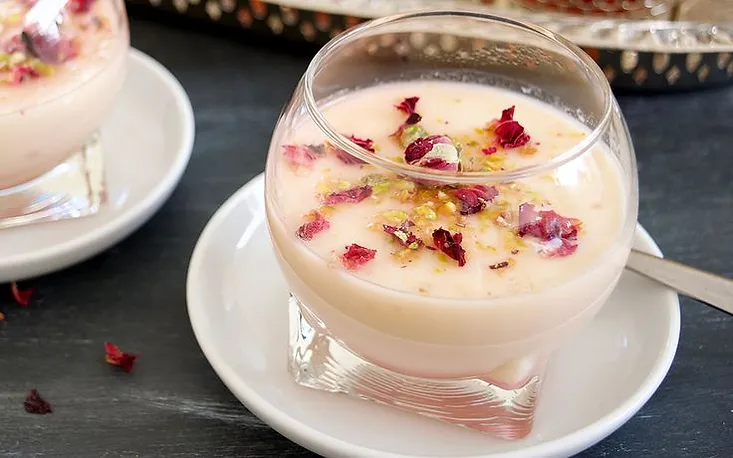Mahalabia, also known as Muhallebi, is a traditional Middle Eastern dessert that has captured the hearts and taste buds of many. This creamy and aromatic pudding is made from simple ingredients like milk, sugar, cornstarch, and the distinct essence of rose water. It’s a staple in many households across the Middle East, especially in Lebanon, where food is not just about sustenance but also about preserving culture and traditions.
The History of Mahalabia
The origin of Mahalabia (Rose Water Milk Pudding) can be traced back to the Arab world, where it was traditionally prepared for special occasions and celebrations. Over centuries, it has evolved into a beloved dessert, enjoyed by people of all ages. The simplicity of its preparation, combined with the luxurious taste of rose water, makes Mahalabia a go-to dessert after a hearty meal.
In Lebanon, Mahalabia holds a special place among traditional Middle Eastern desserts. The Lebanese variation often includes a topping of crushed pistachios or a sprinkle of cinnamon, adding a delightful crunch and a burst of flavor that complements the pudding's creamy texture.
How to Make Mahalabia
Making Mahalabia is surprisingly straightforward, yet the result is a dessert that feels luxurious. Here’s a basic recipe:
Ingredients:
- 4 cups of milk
- 1/2 cup of sugar
- 1/2 cup of cornstarch
- 2 tablespoons of rose water
- A handful of crushed pistachios for garnish
Instructions:
- In a saucepan, mix the milk and sugar over medium heat until the sugar dissolves.
- In a separate bowl, dissolve the cornstarch in a little bit of cold water to create a slurry.
- Gradually add the cornstarch mixture to the milk, stirring constantly to avoid lumps.
- Continue stirring until the mixture thickens to a pudding-like consistency.
- Remove the saucepan from heat and stir in the rose water.
- Pour the mixture into serving bowls and allow it to cool.
- Garnish with crushed pistachios or a sprinkle of cinnamon, and refrigerate for at least two hours before serving.
The result is a silky-smooth pudding with a delicate rose water fragrance that transports you to the Middle East with every spoonful.
Traditional Middle Eastern Desserts: A Culinary Journey
Mahalabia is just one of the many traditional Middle Eastern desserts that have stood the test of time. From the flaky, nut-filled baklava to the honey-soaked knafeh, Middle Eastern desserts are known for their rich flavors and intricate preparations. These desserts are often sweetened with natural ingredients like honey and dates, and flavored with aromatic spices such as cardamom and saffron.
Lebanese cuisine, in particular, is famous for its desserts. Alongside Mahalabia, you’ll find treats like Maamoul, a shortbread pastry filled with dates, nuts, or figs, and Atayef, a stuffed pancake typically served during Ramadan. Each dessert tells a story of the region’s history, blending influences from the Arab world, the Mediterranean, and beyond.
Best Lebanese Food and Sustainability
When we talk about best Lebanese food and sustainability, it’s impossible to ignore the sustainability practices that have been integral to the cuisine for generations. Lebanese cooking emphasizes fresh, local ingredients, and traditional farming practices that minimize environmental impact. Many Lebanese dishes, including desserts like Mahalabia, are made using ingredients that are readily available and sustainably sourced.
For instance, the use of rose water in Mahalabia is not just for its flavor; it’s also a nod to the sustainable practices of extracting and using local resources. Similarly, the pistachios often used in Lebanese desserts are grown in the region, supporting local agriculture.
Lebanese food is a celebration of natural flavors, and its approach to sustainability is something the world can learn from. By focusing on seasonal ingredients and minimizing waste, Lebanese cuisine offers a model for sustainable eating that is both delicious and responsible.
FAQs about Mahalabia and Middle Eastern Desserts
Q: What is Mahalabia? A: Mahalabia is a traditional Middle Eastern dessert made from milk, sugar, cornstarch, and rose water. It has a creamy texture and a fragrant aroma, often garnished with crushed nuts or cinnamon.
Q: How is Mahalabia different from other puddings? A: Mahalabia is distinct because of its use of rose water, which gives it a unique floral flavor that sets it apart from other milk-based puddings.
Q: Can Mahalabia be made vegan? A: Yes, Mahalabia can be made vegan by substituting dairy milk with plant-based milk such as almond or coconut milk.
Q: What are some other traditional Middle Eastern desserts? A: Other traditional Middle Eastern desserts include Baklava, Knafeh, Maamoul, and Atayef.
Q: How does Lebanese food incorporate sustainability? A: Lebanese cuisine emphasizes the use of fresh, local ingredients, often sourced from sustainable farming practices. This approach helps in reducing the environmental impact and supports local communities.



